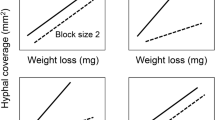Summary
Growth and subsequent decay by seven basidiomycetes in birch wood blocks was inhibited by three Scytalidium isolates. Scytalidium initially colonized the surface of the blocks and gradually overgrew the basidiomycetes. In individual wood blocks from 11 Scytalidium-basidiomycete paired treatment combinations, the basidiomycete was not inhibited throughout the entire wood block. These wood blocks demonstrated interspecific interactions and antagonism between the different fungi. The white-rot fungi responded to isolates of Scytalidium by occluding xylem cells with masses of hyphae, forming pseudosclerotial plates in the zone of initial interaction. Scytalidium appeared to gain access into portions of wood colonized by the basidiomycetes only after substantial decay had resulted by the wood decay fungus.
Similar content being viewed by others
References
Blanchette, R. A.; Shaw, C. G. 1978: Associations among bacteria, yeasts and basidiomycetes during wood decay. Phytopathology 68: 631–637
Bruce, A.; King, B. 1983: Biological control of wood decay by Lentinus lepideus (Fr.) produced by Scytalidium and Trichoderma residues. Mat. Org. 21: 1–13
Harder, R. 1911: Über das Verhalten von Basidiomyceten und Ascomyceten in Mischkulturen. Naturwissensch. Zeitschr. Forst- und Landwirtsch. 9: 3
Hulme, M. A.; Shields, J. K. 1972: Interaction between fungi in wood blocks. Can. J. Bot. 50: 1421–1427
Klingstrom, A.; Beyer, L. 1965: Two new species of Scytalidium with antagonistic properties to Fomes annosus. Svensk Botanisk Tidskrift. 59: 30–36
Klingstrom, A. E.; Johansson, S. M. 1973: Antagonism of Scytalidium isolates against decay fungi. Phytopathology 63: 473–479
Li, C. Y. 1983: Melanin-like pigment in zone lines of Phellinus weirii-colonized wood. Mycologia 75: 562–566
Lopez-Real, J. M. 1975: Formation of pseudosclerotia (zone lines) in wood decayed by Armillaria mellea and Stereum hirsutum. I. Morphological aspects. Trans. Br. Mycol. Soc. 64: 465–471
Lundborg, A.; Unestam, T. 1980: Antagonism against Fomes annosus. Comparison between different test methods in vitro and in vivo. Mycopathologia 70: 107–115
Mallet, P. I.; Hiratsuka, Y. 1986: Nature of the “black line” produced between different biological species of the Armillaria mellea complex. Can. J. Bot. 64: 2588–2590
Morris, P. I.; Dickinson, D. J. 1981: Laboratory studies on the antagonistic properties of Scytalidium spp. to basidiomycetes with regard to biological control. Internat. Res. Group Wood Preserv. IRG/WP/1130
Morris, P. I.; Summers, N. A.; Dickinson, D. J. 1986: The leachability and specificity of the biological protection of timber using Scytalidium sp. and Trichoderma sp. Internat. Res. Group Wood Pres. IRG/WP/1302
Nelson, E. E. 1975: Survival of Poria weirii in wood buried in urea-amended forest soil. Phytopathology 65: 501–502
Nilsson, T. 1973: Studies on wood degradation and cellulolytic activity of microfungi. Stud. For-Suec. Nr. 104: 1–40
Rayner, A. D. M.; Todd, N. K. 1979: Population and community structure and dynamics of fungi in decaying wood. Advan. Botan. Res. 7: 333–420
Ricard, J. L.; Bollen, W. B. 1968: Inhibition of Poria carbonica by Scytalidium sp., an imperfect fungus isolated from Douglas fir poles. Can. J. Bot. 46: 643–647
Stillwell, M. A. 1966: A growth inhibitor produced by Cryptosporiopsis sp., an imperfect fungus isolated from yellow birch, Betula alleghaniensis. Britt. Can. J. Bot. 44: 259–267
Stillwell, M. A.; Wall, R.E.; Strunz, G. M. 1973: Production, isolation and antifungal activity of scytalidin, a metabolite of Scytalidium species. Can. J. Microbiol. 19: 597–602
Stranks, D. W. 1976: Scytalidin, hyalodendrin, cryptosporiopsin — Antibiotics for prevention of blue stain in white pine sapwood. Wood Sci. 9: 110–112
Strunz, G. M.; Kakushima, M.; Stillwell, M. A. 1972: Scytalidin, a new fungitoxic metabolite produced by a Scytalidium species. J. Chem. Soc. Perk. I: 2280–2283
Unligil, H. H. 1978: Decay resistance of wood treated with fungal antibiotics: cryptosporiopsin, hyalodendrin and scytalidin. Wood Sci. 11: 30–32
Author information
Authors and Affiliations
Rights and permissions
About this article
Cite this article
Cease, K.R., Blanchette, R.A. & Highley, T.L. Interactions between Scytalidium species and brown- or white-rot basidiomycetes in birch wood. Wood Sci. Technol. 23, 151–161 (1989). https://doi.org/10.1007/BF00350937
Received:
Issue Date:
DOI: https://doi.org/10.1007/BF00350937




